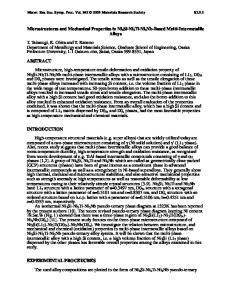Cryogenic properties of a P/M Ni 3 Al-B alloy
- PDF / 366,361 Bytes
- 2 Pages / 594 x 774 pts Page_size
- 15 Downloads / 277 Views
Communications Cryogenic Properties of a P/M Ni3AI-B Alloy K . - M . CHANG, S, C. H U A N G , A. I. TAUB, G. -M. CHANG, and J. W. MORRIS, Jr. Polycrystalline Ni3Al-based intermetallic alloys have overcome their room temperature brittleness problem with a small amount of boron addition. 1.2.3 Because of their unique strength-temperature relationship and good oxidation resistance at high temperatures, research efforts have been concentrated extensively on structural applications at elevated temperatures. 4 In this paper we show that ductile Ni3A1-B alloys also exhibit remarkable mechanical properties at cryogenic temperatures. The nominal composition of the alloy studied is given in Table I. The equivalent aluminum concentration, defined as the total atomic percents of A1 and other elements that substitute for A1, is designed to be 23.8 pet since the boron ductilization in Ni3AI intermetallics occurs most effectively with a substoichiometric composition. 5 The boron addition is set at 0.24 at. pet. One 8 kg heat was prepared by vacuum induction melting using high purity raw materials. The ingot was remelted and atomized into powders by argon atomization. Screened powders of - 140 mesh were canned, evacuated, and sealed in vacuum. The consolidation was carried out by hot isostatic pressing (HIP) at 1150 ~ MPa for two hours. The alloy, designated as T144, was then cold rolled 20 pet, followed by annealing at 1000 ~ for one hour. Alloy T144 has a fully recrystallized, equiaxed grain structure after the annealing treatment; the grain size is ASTM 10 (10 to 15 /xm) as seen in Figure 1. The alloy consists predominately of the LI2 type ordered phase with only a trace amount of secondary phase particles detected. Table II lists the measured tensile properties at different temperatures. Alloy T144 in the annealed condition shows 40 pet elongation at room temperature, with necking observed after the alloy reaches its ultimate tensile strength. This excellent ductility is retained through the cryogenic temperature regime down to liquid helium temperature (4 K). Unlike other intermetallic alloys, ductile Ni~AI-B
Table I. wt pct at. pct
Ni bal. bal.
Co 11.5 10.24
Table II. Low Temperature Tensile Properties of P/M T144 Alloy Testing Temperature K 673 298 77 4
Yield Tensile Strength Strength MPa MPa Annealed 690 1351 575 1441 641 1757 660 1929 682 1915 Cold Worked 1585 1745 1758 2086
298 77
Final Elongation Pet 42 40 38 4O 37 12 14
Chemical Composition of P/M T144 Alloy A1 11.5 22.35
K. -M. CHANG, S.C. HUANG, and A. I. TAUB are Staff Scientists, Materials Laboratory, General Electric Company. Corporate Research and Development, Schenectady. NY 12301 G.-M. CHANG, Graduate Student, and J W. MORRIS, J r , Professor, are with the Department of Materials Science and Mineral Engineering and Center for Advanced Materials, Lawrence Berkeley Laboratory, University of California, Berkeley, CA 94720 Manuscript submitted December 17, 1986
METALLURGICAL TRANSACTIONS A
Fig l--Metallography of annealed P/M T144 alloy
Hf 1.75 0.51
Mo
Data Loading...











